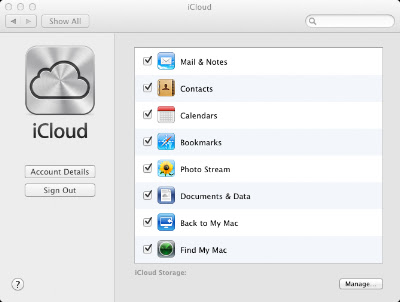Well, to start out, iCloud is basically a lot like DropBox or any other file storing applications out there. I was never really into all of that before because it required work and time. I had to research it, then I had to sign up, blah blah blah. But I have a friend who had the developer version of iOS 5, the operating system on your iPhone, iPod Touch, and your iPads. He kept talking about "iCloud," which sounded strange to me. So when they first announced the features, I swear I read the iCloud page at least 10 times until I had practically memorized it!
Apple made it super easy to change the settings in iCloud, start it up, and even retrieve documents from the cloud. To set it up, you simply go to your settings,
press iCloud, and type in your Apple ID (which is the same thing you use to sign into iTunes and the App Store with). This is the same throughout all devices. To configure it, simply just turn on or off the features and boom! You've got everything going through the cloud. Even to retrieve or to put documents in the cloud is as easy as drag-and-drop.
To start out, iCloud is basically your own little piece of the internet. It's like owning an Apple stock, except it doesn't cost $400. Instead, they provide a free service to store up to 5 GB of data on there for you. They have upgrade plans for people that need more space, but for me, 5 GB is plenty. You can use your 5 GB on anything between contacts to documents. You could have a billion photos on there, and not even OWN Pages, Keynote or Numbers. But that's OK. It's your free space. Nobody can tell you how to spend it.
So maybe this is your first time to even look at that option in the settings. You'll put in your Apple ID just like I explained, and then you'll see a couple buttons. You should see this:
 |
| My iCloud screen. I removed my name and storage. |
So basically, once you have it turned on on all of your devices, say, your iPad, iPhone and Mac, all of the photos you take on your iPhone will automatically go to your other devices. Then maybe you bookmark something on your iPad, then you will have it on your iPhone. Maybe you drag a document into iCloud.com from your Mac, then you can watch it download almost immediately onto your iPhone and iPad. Then you could edit the document from your iPad, and see it update on your iPhone and on iCloud.com. There are endless possibilities; it's up to you to find them.